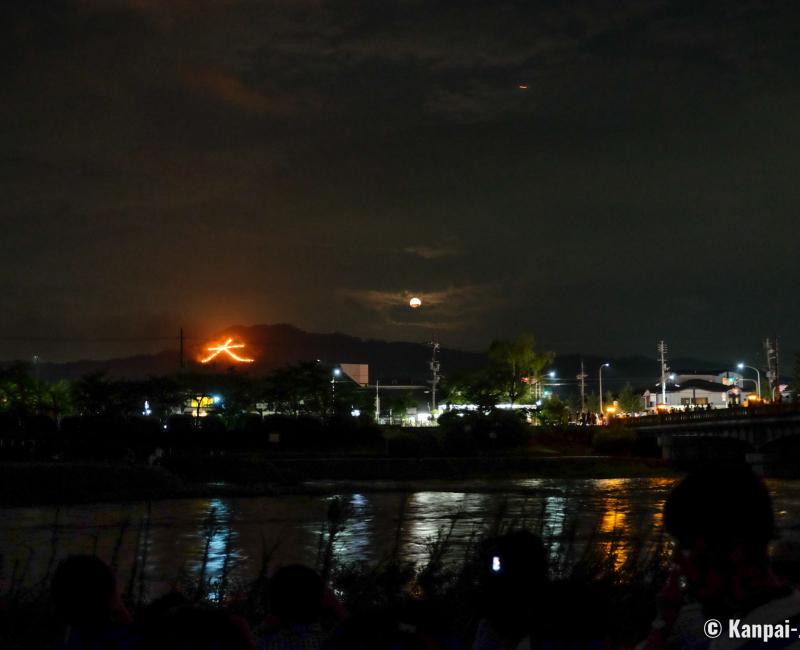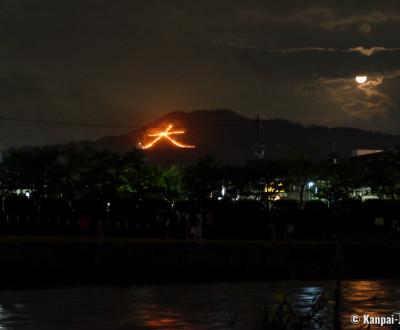Gozan no Okuribi
🔥 Daimonji’s Giant Bonfire Festival
Gozan no Okuribi is a bonfire festival in Kyoto, held each year on August 16 to celebrate the end of Obon, the period of veneration of the dead. On the mountains surrounding the former imperial capital, fire pits laid out to form giant kanji characters are kindled at the beginning of the night. An average of 28,000 viewers, dispatched throughout various observation sites in town, enjoy these illuminations.
Gozan no Okuribi is included in the festival category but its solemnity and its staging on several hills surrounding Kyoto make it very distinct form the usual matsuri. Moreover, it only lasts about one hour, on one single evening. Therefore, do not expect to find matsuri’s usual typical village fair atmosphere: there are no food stalls, no games nor fireworks.
Gozan no okuribi means "the 5 mountains send-off fires" and is a ritual related to the celebration of the dead, Obon. According to the tradition, the souls of the deceased come back to the world of the living during a short period, at the end of which they have to return in the Other World: the fires are placed on the mountains to help them find they way back.
Unclear origins of the ritual
While there is actually no formal proof, the ritual is said to date back at least to the Heian period (794 – 1185) and that it was initiated by famous Buddhist monk Kobo Daishi (Kukai). Documentation on the festival started during Edo period (1603 – 1868), showing that the tradition was essentially popular and not limited to Kyoto. The former capital’s neighboring communities did indeed also built bonfire characters, taking advantage of hill tops stripped of their trees by forestry.
The tradition was suspended a few years during World War II and its current unfolding was codified in the early 1960s, in the perspective of tourism development.
How does Gozan no Okuribi take place?
On August 16, from sunrise to early afternoon, wooden strips called gomaki (護摩木) are collected near the bonfire sites, and especially in Ginkaku-ji, as this temple is located on Mount Daimonji, the site of the matsuri’s main kanji. Anyone can bring their gomaki, which are inscribed with the names of the deceased to honor or wishes. The wooden plates will be incinerated on the same night providing a payed offering.
Volunteers transport the gomaki they have assembled in bundles to the fire pits. Depending on their location, these burning structures can be several meters high, thanks to the stacking of gomaki, "ordinary" wood and other combustible materials.
The ritual itself starts at 7 p.m., with sutra reading at the Silver Pavilion, then the characters are successively lit up in 5 to 10 minutes intervals from 8 p.m., in the following sequence:
- The kanji 大 (dai "large" or "big") on Mount Daimonji in the east, which is constituted of 75 pits, and extends on a 160-meters length and more than 100-meters width. Aside its size, it is also characterized by a bigger central fire, named kanao or kanawa (金尾),
- In the center, on Mounts Matsugasaki Nishi-yama (west) and Higashi-yama (east), the two characters 妙 (myô) and 法 (hô) symbolize the teaching of Buddha. Both kanji extend on a 100 per 100 meters superficies each and respectively have 103 and 63 fires,
- The shape of a boat on Mount Funa-yama in Nishigamo in the north-west, is made of 79 fires, spanning on 150 long and 200 meters wide,
- The kanji 大 on Mount Daihoku-san, also named hidari daimonji (左大文字 "the great character on the left ") for its western position. It is made of 53 fires placed in a roughly 70 per 60 meters area.
- Lastly, the torii form, in the shape of the traditional shrine gate, on Mount Mandara-yama in the south-west. It is made of 108 fires in a 75 meters square.
Each character or form was designed to burn during about 30 minutes in the night.

A scaled-down event in 2020 and 2021
In 2020, the Coronavirus pandemic impacted Gozan no Okuribi’s organization, but it was nonetheless held on a smaller scale. The down-scaling aimed at protecting the volunteers who transport the wood manually, and to avoid crowd gathering. Therefore, only a few fires were symbolically lit:
- 6 fires out of the 75 for 大 on Mount Daimonji,
- 2 out of 108 for the torii gate,
- 1 for each other character.
In 2021, the event was also toned down to accommodate sanitary precautions regarding the Coronavirus.
Where to watch Gozan no Okuribi?
It is almost impossible to watch the five characters in the same night, unless one is willing to move quite far and probably lose a part of the sight’s magic. However, the confluence of Katsura and Kamo Rivers near Demachiyanagi in the south of Kyoto is often mentioned as the best spot to watch the illuminations. It is indeed one of the Japanese’s favorite and they gather in groups with drinks and food bought at the nearby konbini. The place is indeed interesting to experience a popular atmosphere, but we advise bringing your own food and drinks without relying on the area’s stores.
The other several observation spots throughout Kyoto only allow the viewing of one or two mounts at the same time, such as:
- Kyoto Imperial Palace’s Park Kyoto Gyoen, with a view on Daimonji,
- Yoshida-yama, in the surroundings of Ginkaku-ji, offers at the same time a view on Daimonji and on Mount Funa-Yama,
- The ideograms myô and hô are viewable from Kyoto Notre-Dame University, near Kyoto Botanical Garden,
- The boat shape is viewable from Misono Bridge near Kamo-jinja shrine, and the banks of Kamogawa River,
- Shikichi-jinja shrine, near Kitano Tenmangu, allows to observe hidari daimonji on Mount Hokusan,
- The torii is easily viewable from the surroundings of Daikaku-ji temple.
Access to the rivers’ banks is free. More comfortable but paying solutions are available, located on the tops of Kyoto’s tallest buildings:
- Kyoto station,
- Kyoto Tower, and,
- Hotels or restaurants’ rooftops.
However, advance booking is required and places are scarce.
Do not think of approaching the fire pits areas: access to the mountains is forbidden on the D-day, for security reason and allowing the construction of the pyres. Moreover, the use of drone is forbidden. Night hiking is also to avoid as it can be dangerous.
A unique event, but not a must-see
Watching Gozan no Okuribi is a nice experience, especially for those who want to offer a gomaki, but planning a sightseeing trip solely for this event is unnecessary. The viewing can be prevented or disturbed by bad weather, and some may find it disappointing to not be able to watch the five burning mounts at the same time.
Gozan no Okuribi can however be a highlight after a sightseeing day near one of the observation spots mentioned earlier: the fire pits are permanent structures in areas devoid of trees which allows to identify the place beforehand, especially for photographs who would like to shoot at least one character.

